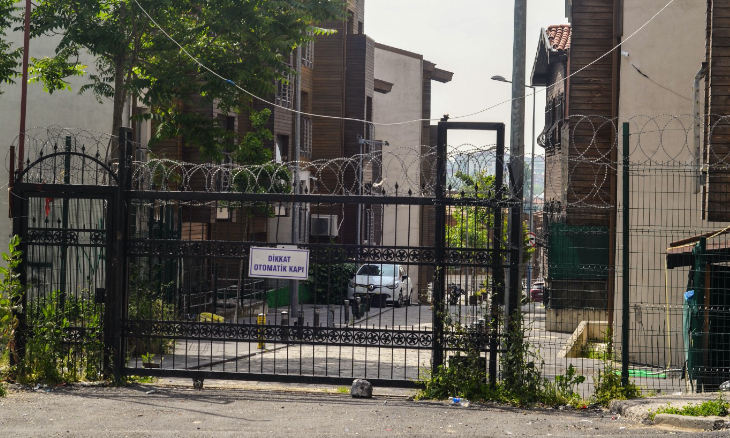Remember Sulukule?
In 2008, then-Prime Minister Recep Tayyip Erdoğan vowed to “save Sulukule from its state of monstrosity” invoking the same word for monstrosity (ucube) he later used to describe the Statue of Humanity, a sculpture built in the eastern province of Kars to symbolize friendship between Turkey and Armenia. Like Sulukule, the statue was torn down.
Last week, the Istanbul Metropolitan Municipality (İBB) demolished iron gates that enclosed a neighborhood of modern apartments built up against the city's 5th-century walls.
These buildings, designed in a vaguely late-Ottoman style, were constructed over the remains of Sulukule, a historic Roma neighborhood that was razed to the ground in 2009, constituting one of the worst urban disasters in modern Istanbul.
Longtime Roma rights activist Hacer Foggo thanked Istanbul Mayor Ekrem İmamoğlu in a tweet, writing that the gates prevented former Sulukule residents from entering the area. “These gates separated, dissociated and marginalized them,” Foggo said.
The story was picked up by several local media outlets, but like everything else on the agenda, it was quickly buried in the frenzy surrounding the controversial court decision that converted Istanbul's Hagia Sophia from a museum to a mosque. Notwithstanding, it is hard to forget about what happened to Sulukule, in spite of the impossibly eventful decade that has followed since its destruction.
Despite Sulukule's centuries of history, pivotal location in the heart of the old city, and prominent display in a scene of From Russia With Love, it has been an unwanted, stigmatized space for decades. During the 1990s, the rowdy entertainment venues that the area was famous for were repeatedly targeted by the authorities and eventually shuttered, devastating the local economy.
In 2008, then-Prime Minister Recep Tayyip Erdoğan vowed to “save Sulukule from its state of monstrosity” invoking the same word for monstrosity (ucube) he later used to describe the Statue of Humanity, a sculpture built in the eastern province of Kars to symbolize friendship between Turkey and Armenia. Like Sulukule, the statue was torn down.
A former resident compared the fate of Sulukule and its Roma population to the Palestinians in an interview with Medyascope on Friday:

“We became just like Palestine. We came here in 1893 but were thrown out. My grandfather, who was born in 1926, grew up here but what did we become? We became the foreigners. It's as if that is Israel, and we are Palestine,” the resident said of the new Sulukule, where a large number of renters are foreign nationals.
Istanbul's Roma have been among those hit the hardest by aggressive urban development, as the neighborhoods of Hacıhüsrev, Sarıgöl, Küçükbakkalköy, Tarlabaşı and Dolapdere, all of which have large Roma populations, have witnessed major demolitions and restructuring in recent years.
Next to the new Sulukule is Karagümrük, a working-class neighborhood where many Roma moved to after their homes were destroyed. Often wide open, the gates around Sulukule were more symbolic than functional, seeking to provide the illusion of safety for the new residents and reminding the Roma living nearby that they aren't welcome back. Roma activists tried for years to have the gates removed, and only after appealing to Istanbul Mayor Ekrem İmamoğlu was their request granted.
On Friday after the Hagia Sophia decision was announced, İmamoğlu chose to refrain from commenting. “We did whatever the 16 million people of Istanbul wanted. We will continue to do so all together,” he tweeted with a video highlighting some of the public service projects that the İBB has carried out during his tenure.
Honoring the Roma community's requests to have the gates closing off their old neighborhood demolished is a keen example of directly serving the public interest, and a gesture of good faith toward the Roma whose Istanbul has been a particularly hostile place to live over the past 15 years.
However, it was inevitable that Istanbul's mayor would have to break his silence on Hagia Sophia, and did so in a statement on Monday that is unlikely to appease his detractors nor satisfy many of his supporters:
“Hagia Sophia has been a mosque in my mind and in my conscience since 1453,” Imamoğlu said, adding that he has always referred to it as the Hagia Sophia Mosque in previous speeches, and blasted pro-government television channels for not knowing its modern history:
“In fact, for 30 years the call to prayer has been read five times a day at the Hagia Sophia. Prayers are performed inside at the Abdülmecit prayer room. There has been a sign up since 1991. If you are sensitive about this subject, and you say 'the first call to prayer has been read' or 'the first prayer will be performed on July 24,' this is very troubling,” İmamoğlu said.
The unfortunate consequence of Istanbul's unparalleled, complicated history and collection of splendid, significant monuments is the city's endless politicization, while its premium location, rapid growth and status as the country's economic hub has resulted in perpetual destruction and displacement.

